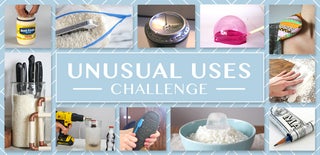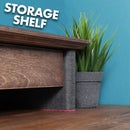Introduction: Cityscape Light - for Birmingham Childrens Hospital
The Birmingham Children's Hospital is very close to my heart. They saved my life numerous times so when Toolstop & DeWalt wanted to create some projects to auction off to raise money for them, I was all for it.
This is the first of those projects. A Cityscape LED Light.
I have a full build video, including a fail at the start here:
Materials Used:
- Plywood
- American Black Walnut
- Epoxy Resin
- Colour Pigment
- LED Strip Light
- Hot Glue
- Wood Glue
- Black Acrylic Paint
- Spray Lacquer
- Milliput Epoxy Putty
- Sandpaper
- Painters Tape
Tools Used:
- Mitre Saw
- Jigsaw
- Combi Drill
- Planer
- Screwdriver
- Router
- Clamps
- Hand File
- Profile Router Bit
Step 1: Create Plywood Base
Once I had my failure out of the way I made a start by cutting 3 pieces of 18mm (3/4 inch) Plywood. The 3 pieces measured 85mm x 350mm (3 - 3/8" x 13 - 3/4").
2 of those pieces get the centres cut out so first I marked in 10mm (3/8") from all 4 sides to create a boarder. I then drilled a hole at each corner big enough for my jigsaw blade to fit through.
It was then just a case of cutting to the line to remove the centre piece.
With those 2 pieces cut it was time to glue up the base. They stack on top of each other with the 2 pieces that have the centres removed at the bottom. A couple of clamps holds them together while the glue dries.
Step 2: Route Groves in Plywood Base
There needs to be 2 grooves in the base to receive the 'Citsyscape' and the LED light strip. I used a guide fence attached to my trim router set to 12mm (1/2") away from the cutter. This will create a groove 12mm (1/2") in from the outside edge of the plywood base.
The groove for the 'Cityscape' was cut using a 16mm (5/8") straight bit. I cut to a depth of 15mm (9/16").
The Groove for the LED Light Strip was cut using a 12mm (1/2") straight bit. I cut to a depth of 5mm (3/16").
With the grooves cut I used a chisel to square up the rounded corners.
Step 3: Create the Cityscape
I had some scraps of walnut that were ideal for this project.
The pieces were roughly 16mm x 20mm (5/8" x 13/16"). There were a couple of thinner pieces too. The only thing that is really critical with these sizes is the thickness needs to match the groove you cut. In my case that was 16mm (5/8").
My pieces were rough sawn so the planer was used to smooth and flatten the sides. I then cut them to random lengths at the mitre saw. I didn't have a particular cityscape in mind I just knew I wanted it tallest in the centre and I didn't want all flat top buildings so I also cut some angles too. To make sure the 'buildings' looked like individual pieces and not just one panel when glued up I heavily sanded the edges.
It was then just a case of gluing the pieces together. I made sure the bottoms were all flush.
Step 4: Create the Stylised Birmingham Childrens Hospital Logo
The Birmingham Children's Hospital's logo is a balloon so I drew on a rough balloon shape with its string attached. Then using a large drill bit I drilled 2 holes in the balloon shape. I joined up the holes with the jigsaw and then smoothed out the shape with a hand file.
I clamped a scrap piece of Melamine to the front of the hole so the resin wouldn't run everywhere. The epoxy resin I use doesn't stick to Melamine so that's why I chose to use it. I mixed the epoxy resin's 2 parts together and added a tiny amount of red pigment. I wanted the balloon to remain semi translucent so the light will shine though. It was then just a case of pouring the resin into the hole and leaving it to set.
Step 5: Create the Walnut Base
While the resin was setting I started work on creating the Walnut base. I cut it to match the dimensions of the plywood base. So the walnut measured 85mm x 350mm x 25mm (3 - 3/8" x 13 - 3/4" x 1").
So the plywood base would side over the walnut base I marked in 12mm (1/2") from all 4 edges. I also marked an area that will house the LED electronics. I used the router to remove the material needed. I created the pocket for the electronics first, this was cut to a depth of 15mm (9/16"). Then with a guide fence attached I routed the reveal around the edge to a depth of 15mm (9/16").
I wanted a 6mm (1/4") gap reveal all round the base when the plywood was seated on top. This should give the look of floating. To achieve this I added 2 scrap blocks of walnut. They simply got glued into place.
While the glue was drying I drilled a hole in the plywood base. The hole was drilled in the groove that was created for the LED Strip. It was positioned above where the pocket was on the walnut base. This will be where the LED light strip feeds through. When the glue was dry on the walnut blocks I could give it all a test fit. i was happy with the reveal at the bottom so I drilled a couple of pilot holes to receive screws later.
To finish off the plywood base I use the router with a chamfer bit installed to chamfer the top edges.
Step 6: Back to the Cityscape & Balloon
When the resin was set for the balloon I removed the melamine to see how the casting went. I was really happy with the results.
To create the string to the balloon I installed a profile bit into the router and freehand carved the line. I then used some black Milliput epoxy putty to fill in the line. This sets solid when fully cured. I left it overnight to cure then came back the next morning to sand it flush and reveal the design. To clean up the groove I used a chisel.
I then sanded the entire cityscape to 240 grit.
Step 7: Finish the Base & Glue Up
The LED electronics have a infrared receiver for a remote control. So this would still work, I drilled a hole through the front and into the pocket of the walnut base. I also drilled hole through the back into the pocket for the power the feed through.
To make reveal look more like its floating I painted the reveal with black acrylic paint. I masked off the base with painters tape to protect it from the paint.
While the paint was drying I glued the walnut cityscape into the groove in the plywood base.
Step 8: Finish
With everything dry it was time to add a finish to everything. I used spray lacquer for the finish. All the pieces got 5 coats of lacquer. I sanded between each coat with 240 grit sand paper.
With the finish dry it was time to add the electronics. The infrared receiver was secured into the front hole of the walnut base using hot glue. The power lead fed through the holed in the back of the walnut base and plugged into the white box. The LED light stripe also plugged into the white box and then fed up through the hole in the plywood base. The LED light strip had a self adhesive coating on the back but I still added some beads on hot glue over the top to help secure it into the place. It fit nicely into the groove.
To complete the piece it was just a case of adding 2 screws where I drilled the pilot holes earlier. This secures everything together while still giving easy access to the electronics inside. They cant be seen behind the cityscape.
Step 9: Done
This is the light done! I really hope you liked it. The light will be auctioned off to raise money for The Birmingham Children's Hospital. I don't have the information about the auction yet as Toolstop will be running it. I will be making an announcement on my YouTube channel as soon as I know more.
https://goo.gl/9QksSM

Participated in the
Home Improvement Contest 2017

Participated in the
Unusual Uses Challenge 2017













